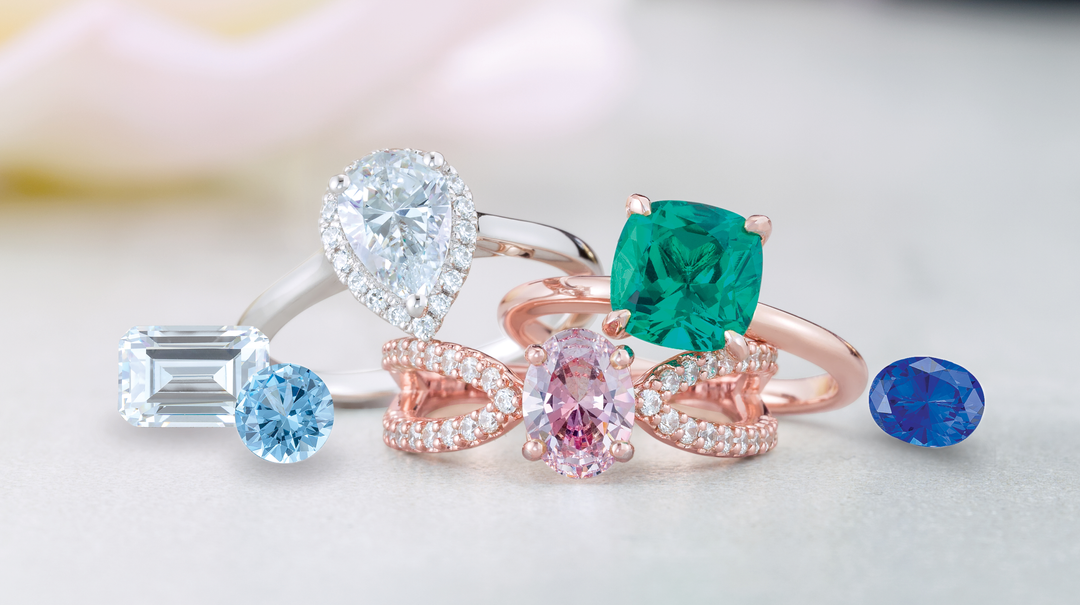
Diamonds have long been considered the pinnacle of luxury, elegance, and durability. However, due to ethical concerns, environmental impact, and cost, many individuals are now turning to alternatives that resemble diamonds in appearance and physical properties but offer a more affordable and sustainable choice. This article will explore some of the most popular diamond substitutes and the reasons behind their growing popularity.
Table of Contents
Why Consider Diamond Substitutes?
Diamonds, while beautiful and enduring, come with a hefty price tag. The average price of a diamond engagement ring can be quite steep, leading many consumers to seek alternatives that offer similar aesthetic qualities at a fraction of the cost. Additionally, issues surrounding the diamond industry, including mining practices, the environmental toll, and the potential for conflict diamonds (also known as “blood diamonds”), have made ethical concerns a driving force behind the search for substitutes.
Here are the most common diamond substitutes that are gaining popularity:
1. Moissanite: The Leading Alternative
Moissanite is arguably the most well-known diamond substitute. First discovered in 1893 by the French chemist Henri Moissan, moissanite is a naturally occurring mineral (silicon carbide) found in meteorites. However, natural moissanite is incredibly rare, and most moissanite used in jewelry today is lab-created.
Why Choose Moissanite?
- Brilliance: Moissanite has a higher refractive index than diamonds, meaning it sparkles more intensely, giving it more “fire” and brilliance.
- Durability: Moissanite ranks 9.25 on the Mohs scale of hardness, just below diamonds (which rank 10). This makes it highly durable and suitable for daily wear.
- Affordability: Moissanite is significantly less expensive than diamonds, making it an attractive choice for those seeking a high-quality gemstone at a lower cost.
- Ethics: Lab-created moissanite provides an ethical alternative to mined diamonds, with no concerns over labor exploitation or environmental damage.
Drawbacks
Moissanite is often slightly tinted with a yellow or green hue under certain light conditions, which can be noticeable in larger stones. However, many people still prefer it for its dazzling brilliance and overall appeal.
2. Cubic Zirconia (CZ): The Budget-Friendly Option
Cubic zirconia is another popular diamond alternative, and for good reason—it is inexpensive, widely available, and comes in a variety of shapes and sizes.
Why Choose Cubic Zirconia?
- Affordability: CZ is one of the most affordable diamond substitutes on the market, costing a fraction of the price of a diamond.
- Appearance: When cut well, CZ can closely resemble diamonds, offering a similar shine and clarity.
- Lightweight: CZ is much lighter than diamonds, making it easier to wear for extended periods.
Drawbacks
- Durability: CZ is softer than diamonds (it ranks 8-8.5 on the Mohs scale), meaning it can scratch and lose its luster more quickly over time.
- Lesser Brilliance: While CZ can be shiny, it doesn’t have the same level of brilliance or fire as a diamond or moissanite. Over time, it can also become cloudy or dull.
3. White Sapphire: A Natural Gemstone Alternative
Sapphires, traditionally blue, also come in a colorless variety that can be used as a diamond substitute. White sapphires are natural gemstones that have been used in fine jewelry for centuries and offer a more subtle and understated alternative to diamonds.
Why Choose White Sapphire?
- Natural Beauty: White sapphires are naturally occurring gemstones, making them appealing to those who want a genuine gem without the high price tag of a diamond.
- Durability: With a hardness of 9 on the Mohs scale, white sapphires are durable and suitable for daily wear, though they can scratch more easily than diamonds or moissanites.
- Ethics: Like other natural gemstones, white sapphires are often mined in ways that are less controversial than diamond mining, depending on the source.
Drawbacks
White sapphires lack the brilliance of diamonds, and their appearance can be less eye-catching. They also have a lower refractive index, which means they don’t sparkle as much under light.
4. Lab-Grown Diamonds: Identical to Natural Diamonds
Lab-grown diamonds (also called synthetic diamonds or man-made diamonds) are chemically identical to natural diamonds but are created in a controlled environment. These diamonds are made through high-pressure, high-temperature (HPHT) or chemical vapor deposition (CVD) methods, replicating the conditions that form natural diamonds deep within the Earth.
Why Choose Lab-Grown Diamonds?
- Identical to Natural Diamonds: Lab-grown diamonds are virtually indistinguishable from natural diamonds in terms of chemical composition, hardness, and appearance. They even have the same optical properties.
- Ethical and Sustainable: Lab-grown diamonds do not involve mining, making them a more sustainable and ethical choice.
- More Affordable: Lab-grown diamonds tend to be 20-40% less expensive than their mined counterparts.
Drawbacks
While lab-grown diamonds offer the same appearance and quality as natural diamonds, some consumers may prefer the idea of a naturally sourced gem. Additionally, lab grown diamonds are still a significant investment compared to some other substitutes.
5. White Topaz: A Lesser-Known Option
Topaz is another natural gemstone that is often used as a diamond alternative. White topaz is colorless and relatively affordable, making it a popular choice for those looking for a budget-friendly gemstone with a diamond-like appearance.
Why Choose White Topaz?
- Affordability: White topaz is considerably cheaper than diamonds, making it a great option for those on a budget.
- Natural Gemstone: As a naturally occurring gem, white topaz offers an authentic alternative to diamonds.
- Variety: White topaz is available in a wide range of shapes and sizes, giving consumers many options for customization.
Drawbacks
White topaz is softer than diamonds (it ranks 8 on the Mohs scale), making it more prone to scratches and wear over time. It also has a lower refractive index, so it doesn’t sparkle as much as diamonds or other substitutes like moissanite.
Conclusion: Which Diamond Substitute is Right for You?
Choosing a diamond substitute depends on various factors, including budget, ethical considerations, and personal preferences. Moissanite and lab-grown diamonds offer the closest alternatives in terms of appearance and durability, while cubic zirconia and white topaz can be more budget-friendly options. White sapphires, on the other hand, provide a more natural choice that still offers a stunning alternative to diamonds.
As consumers increasingly prioritize sustainability and ethical sourcing, diamond substitutes are likely to continue growing in popularity, offering a diverse range of options for those who want beauty, brilliance, and value without compromising on their values.







